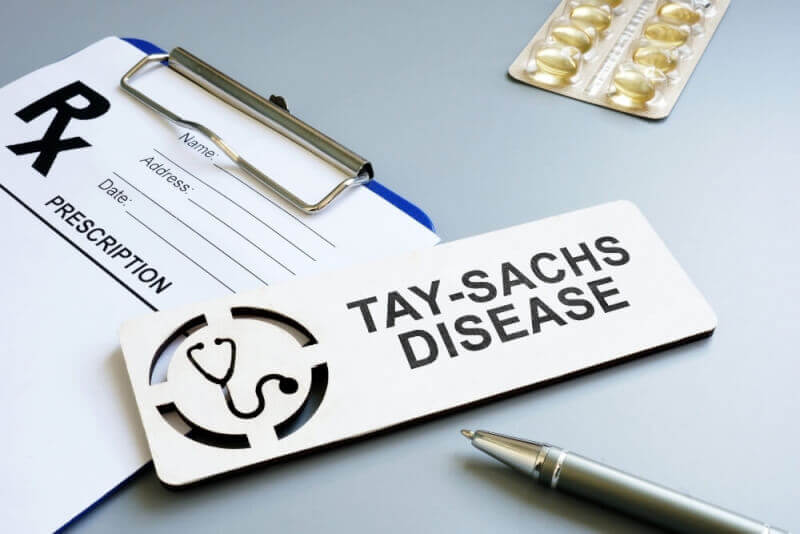What is Tay-Sachs Disease?
Tay-Sachs disease, one of the diseases seen in children, is a genetic condition that ultimately leads to the death of the patient. Symptoms such as developmental delays in the nerve cells in children's brains and spinal cord, hearing and vision loss usually begin around 6 months of age. A progressive disease, Tay-Sachs disease worsens over time, leading to early death. The treatment of Tay-Sachs disease, for which there is no cure yet, supports the child and improves their quality of life.
Types of Tay-Sachs disease
There are 3 subtypes of Tay- Sachs disease. The time of onset of symptoms is used as a criterion for determining the species.
- Classic infantile Tay-Sachs disease is the most common form of Tay-Sachs disease, with symptoms appearing when children are 6 months old.
- In the Juvanil form, the first symptoms appear between the age of 5 and adolescence and it is the rarest form of Tay-Sachs disease.
- In late-onset Tay-Sachs disease, symptoms may appear in late adolescence or early adulthood. In some cases, symptoms may also appear after the patient has passed the age of 30. Late-onset Tay-Sachs disease may not affect patients' life expectancy and is extremely rare.
Tay-Sachs disease is a genetic disease. The type of disease is also genetically inherited. Therefore, if a family has the infantile form, other children in the family are unlikely to have the late-onset form of Tay-Sachs.
How common is Tay- Sachs disease?
As a result of research on Tay- Sachs disease, it is estimated that one in every 300 people has the genetic mutation responsible for Tay- Sachs disease. However, the fact that the number of children born with this disease is really low makes Tay- Sachs disease one of the rarest diseases. Awareness, education and genetic testing can reduce the incidence in the population at risk.
Diagnostic criteria for Tay-Sachs Disease
A blood test is required to diagnose Tay-Sachs disease. A small blood sample from the heel or veins in the arm is sufficient. In this blood sample, the level of the enzyme HEXA A is measured. A child with infantile Tay-Sachs disease is completely missing this protein. In other forms of the disease, these enzyme levels are low. The presence or absence of a red spot in the child's eye is also important for the diagnosis.
Diagnosis of Tay- Sachs disease during pregnancy
Two special tests that can be performed during pregnancy are used to diagnose Tay-Sachs disease. The first of these tests is the amniocentesis test. A sample of the fluid surrounding the fetus is sufficient for this purpose. The second test used to diagnose Tay- Sachs disease during pregnancy is chorionic villus sampling. This requires a sample from the placenta.
In both tests, EXHA A enzyme is searched for in the samples. If the values are below average, the fetus is diagnosed with Tay-Sachs disease.
Symptoms of Tay-Sachs Disease
The symptoms of Tay-Sachs disease vary depending on the age of the child. After the first symptoms, the disease gets progressively worse. The most characteristic symptom of Tay-Sachs disease is that children lack developmental milestones for their age or lose skills they learned earlier.
Symptoms of classic infantile Tay-Sachs disease
These symptoms, which occur when children are 6 months old, include the following
- Muscle weakness
- Difficulty turning, sitting or crawling
- Startled by loud noises
Before children reach the age of one year and as the disease progresses, the following symptoms are added to the symptoms seen in patients.
- Involuntary muscle twitching called myoclonic contraction
- Seizures
- Hearing loss
- Difficulty swallowing
- Respiratory tract infections
- Loss of vision
- Red spot in the eyes
All of these symptoms appear around the age of 2 years. In addition, children's lack of response to stimuli is also among the symptoms that can be seen. When this symptom is present, it means that the child does not have much brain function. The age of death in infantile Tay-Sachs disease usually ranges from 2 to 4 years of age and the cause of death is pneumonia.
Symptoms of juvenile Tay-Sachs disease
After the age of 5, symptoms that can be seen in children include the following.
- Muscle weakness
- Seizures
- Loss of muscle control
- Hearing and vision loss
- Speech difficulty
- Changes in mood and behavior
- Loss of previously learned skills
These symptoms worsen towards the child's teenage years, during which time premature death is possible.
Symptoms of Tay-Sachs disease in late onset
Adults diagnosed with late-onset Tay-Sachs disease may experience the following symptoms.
- Muscle weakness
- Development of psychosis or mental health conditions
- Loss of coordination, called ataxia
- Communication difficulties
- Loss of ability to walk
- Difficulty swallowing
Late-onset Tay-Sachs disease usually does not affect a person's life expectancy.
Causes of Tay-Sachs Disease
It is a mutation in the HEXA gene that causes Tay-Sachs disease. This gene allows enzymes to enter cells.
For Tay-Sachs disease to occur in a child, 2 copies of the genetically mutated HEXA A gene must be present in the child. Normally, this gene exists in 2 copies in each person. Tay-Sachs disease occurs in children who inherit one genetically mutated HEXA A gene from each biological parent. This condition is also called hexosaminidase A deficiency or hex A deficiency
What does Tay-Sachs carrier mean?
A carrier is a person who has a working copy of the HEXA gene that causes Tay-Sachs disease and a copy of the mutation that causes the disease. Carriers have no disease or symptoms due to the presence of the working HEXA gene in their body. If 2 people who carry the genetic variant have a child, then the chances of my child having Tay- Sachs disease are as follows
- There is a 25% chance that the child will not inherit any mutated HEXA gene. If this happens, the child will not be both the carrier and the patient.
- There is a 50% chance that a child will inherit the mutated HEXA gene from one of the parents. If this happens, the child will not get Tay-Sachs disease but will be a carrier. As they will be carriers, they are likely to pass on the mutated gene to their children.
- There is a 25% chance that the child will receive the variant gene from both carrier parents. In this case, the child develops Tay-Sachs disease.
Risk factors for Tay-Sachs disease
If both biological parents have the genetically mutated HEXA A gene, the child has a higher risk of developing Tay- Sachs disease. This mutation can occur in everyone. It is particularly prevalent among French-Canadians, Ashkenazi Jews and people of Eastern European origin.
Treatment of Tay-Sachs disease
There is no cure for Tay-Sachs disease, but there are some treatments to support the symptoms. This includes prescribing medication to prevent seizures. In addition, children should be properly fed and hydrated. Patients are made as comfortable as possible during their lifetime.
Treatment of late-onset Tay-Sachs disease
In the treatment of late-onset Tay- Sachs disease in adulthood, the following therapies are used to help manage symptoms.
- Using assistive devices and mobility equipment to help patients' independence
- Using medicines to maintain mental health conditions
- Taking medication for the prevention of muscle spasms
- Speech therapy
How should a child diagnosed with Tay-Sachs be cared for?
The best way to care for a child diagnosed with Tay-Sachs is to ensure that their symptoms are managed correctly to improve their quality of life. For this, the following points should be carefully considered.
- A significant proportion of Tay-Sachs patients experience breathing problems. They often develop lung infections because their salivary secretions are actively working and they have difficulty swallowing. Adjusting the body position correctly using different medications and devices helps the child to breathe more easily.
- Speech and language pathologists can help the child learn eating and drinking techniques to make feeding easier. However, as swallowing worsens, the child will need a feeding tube.
- In order to manage seizures, which are among the symptoms of the disease, the correct treatment plan should be implemented by a neurologist.
- Finally, children with Tay-Sachs also have problems with the 5 senses. To stimulate these feelings, it is necessary to experiment with soft materials, cell phones, music and relaxing scents.







